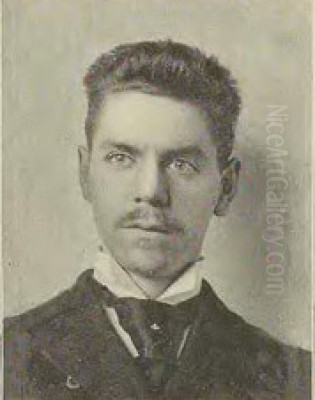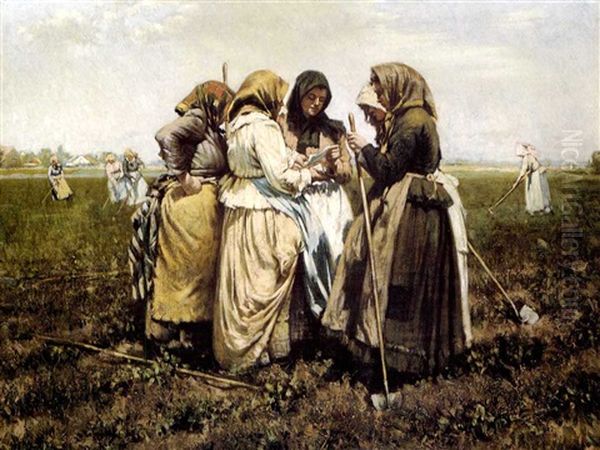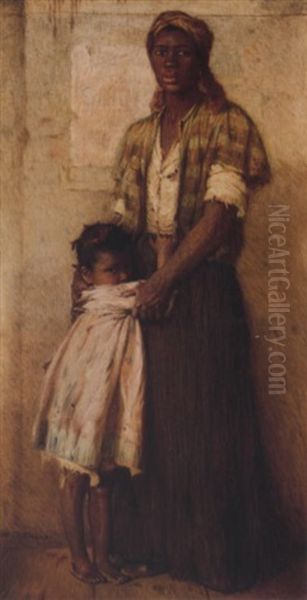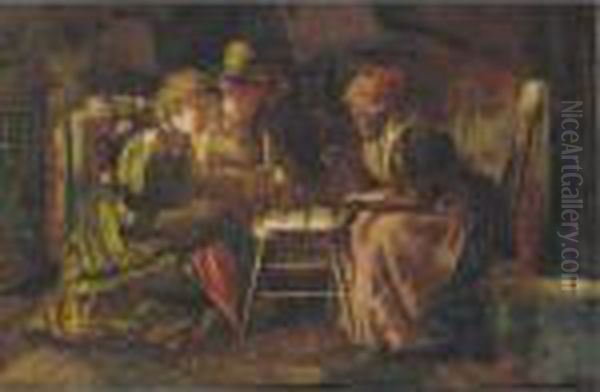
Harry Herman Roseland stands as a distinctive figure in American art history, an artist who dedicated much of his career to depicting the lives of African Americans in the post-Civil War era. Working primarily in the genre painting tradition, Roseland captured domestic scenes, moments of labor, and intimate glimpses into the experiences of a community often marginalized in the broader narrative of American art. Though largely self-taught and rooted firmly in his native Brooklyn, his work gained considerable popularity and recognition during his lifetime, offering a window, albeit sometimes through a sentimental lens, into the realities and cultural practices of Black Americans at the turn of the 20th century.
Early Life and Artistic Formation in Brooklyn
Born in Brooklyn, New York, around 1866 or 1867, Harry Roseland remained a lifelong resident of the borough. Unlike many aspiring American artists of his generation, such as William Merritt Chase or Thomas Eakins, who sought training in the prestigious academies of Paris or Munich, Roseland developed his skills primarily through independent study and observation within his local environment. His decision to forgo European study shaped his perspective, keeping his focus firmly on American subjects and themes.
While predominantly self-taught, Roseland did receive some formal instruction. He studied briefly under John Bernard Whittaker (J.B. Whittaker), an artist associated with the Adelphi Academy in Brooklyn, known for his landscapes and still lifes. He also spent time learning from James Carroll Beckwith, a more prominent figure who taught at the Art Students League of New York and was known for his elegant portraits and figure studies in an academic realist style. These brief periods of instruction likely provided Roseland with foundational techniques in drawing, composition, and oil painting, which he adapted to his own burgeoning style.

Roseland's commitment to Brooklyn extended beyond his residency; he became an active participant in the local art scene. He was a member of the Brooklyn Art Club and later the Brooklyn Society of Artists. These organizations provided venues for exhibition and interaction with fellow artists, fostering a sense of community among painters working outside the dominant Manhattan art circles. His involvement suggests a dedication to contributing to the cultural life of his home borough.
Thematic Focus: Depicting African American Experiences
The most defining aspect of Roseland's oeuvre is his consistent focus on African American subjects, particularly those living in modest circumstances in the decades following the Civil War. While he also painted landscapes, portraits, and scenes of labor involving white figures, his reputation rests largely on his genre scenes portraying Black families, workers, and individuals in everyday settings. These works often carried narrative titles, inviting viewers to interpret the stories unfolding within the canvas.
Interestingly, Roseland reportedly never traveled extensively in the American South, the region most associated with the subjects he depicted. Instead, he relied on readings, photographs, illustrations, and possibly interactions with African Americans in the North to inform his portrayals. This distance perhaps contributed to a degree of idealization or reliance on prevailing archetypes in some of his works, a common characteristic of genre painting from this period which sometimes veered into sentimentality or stereotype.
His subjects ranged from quiet domestic interiors, showing families gathered or individuals engaged in simple tasks, to scenes hinting at social conditions. He frequently depicted elderly figures, often referred to with the affectionate but potentially patronizing term "Mammy" or "Uncle," engaging in activities like reading, sewing, or playing checkers. These portrayals, while sometimes touching, occasionally reflected the racial stereotypes prevalent in popular culture at the time. However, they also often imbued their subjects with dignity and quiet resilience.
Artistic Style: Narrative Realism and Detail
Roseland worked within the tradition of American Realism, focusing on representational accuracy and detailed observation. His style is characterized by careful draftsmanship, a clear rendering of figures and objects, and attention to the textures of fabrics, wood, and domestic settings. He employed a relatively smooth application of paint, building up forms with careful modeling and a controlled use of light and shadow to create convincing interior spaces.

His approach aligns closely with genre painting, which emphasizes storytelling and the depiction of everyday life. Roseland excelled at creating narrative vignettes. Titles like The Doctor's Visit, Checkers Down South and Victory, or An Important Letter explicitly guide the viewer's interpretation. He arranged figures and objects within the composition to suggest relationships, activities, and emotional states. This narrative quality made his work accessible and appealing to a broad audience.
Compared to some of his contemporaries, Roseland's realism was less gritty than that of the Ashcan School painters like Robert Henri or John Sloan, who focused on the raw energy of urban life. It also differed from the more psychologically penetrating portraits of Thomas Eakins or the atmospheric, light-filled canvases of the American Impressionists. Roseland's style was more closely aligned with the narrative genre tradition exemplified by earlier American artists like Eastman Johnson or European painters such as Jean-François Millet, though focused specifically on his chosen subject matter.
Key Works and Recurring Themes
Several paintings stand out as representative of Roseland's career and thematic concerns. Perhaps his most famous and emotionally charged work is To the Highest Bidder, painted around 1906. This large canvas depicts a harrowing scene: a light-skinned African American woman and her young daughter standing on an auction block, implicitly awaiting sale during the era of slavery. The painting's power lies in its direct confrontation with the brutality of chattel slavery and the separation of families. Its significance is underscored by its inclusion in prominent collections, notably that of Oprah Winfrey, and its high auction price, reflecting its historical and artistic importance.
Another recurring and highly popular theme in Roseland's work was the depiction of African American women as fortune tellers, often shown reading tea leaves or cards for white clients. Paintings like Old Mammy's Prediction (1906), Reading Tea Leaves, and the lithograph The Fortune Teller (1898) exemplify this motif. These images tapped into a contemporary fascination with spiritualism and the exotic, portraying Black women as possessors of mystical knowledge. While popular, these depictions also played into stereotypes of Black folk culture. The widespread reproduction of these images on postcards and in newspaper supplements significantly contributed to Roseland's fame.

Roseland received early recognition for his work. His painting An Important Letter won the Second Hallgarten Prize at the prestigious National Academy of Design exhibition in 1898. This award, typically given to promising younger artists, signaled his arrival on the national art scene and validated his focus on genre subjects. Other works, such as those depicting laborers or quiet domestic moments, further solidified his reputation as a skilled painter of everyday life.
Exhibitions, Recognition, and Influence
Throughout his career, Roseland actively exhibited his work, primarily on the East Coast. He showed regularly at the National Academy of Design in New York, the Pennsylvania Academy of the Fine Arts in Philadelphia, and various venues in Brooklyn, including the Brooklyn Art Club and the Brooklyn Museum. His participation in these exhibitions placed his work alongside that of major American artists of the day.
The popularity of his fortune-teller scenes and other genre subjects led to their frequent reproduction. This dissemination through prints, postcards, and illustrations made Roseland's imagery widely recognizable to the American public, extending his influence beyond the confines of the art gallery world. His work became part of the visual culture of the early 20th century, shaping popular perceptions of African American life, for better or worse.
While Roseland achieved considerable popular success and critical recognition during his lifetime, his direct influence on subsequent generations of artists appears limited. He did not establish a distinct school or attract a large following of students in the manner of influential teachers like Robert Henri or William Merritt Chase. His artistic connections seem primarily rooted in the Brooklyn art community through organizations like the Brooklyn Art Club, where he would have interacted with other local painters. His teachers, J.B. Whittaker and James Carroll Beckwith, represent his main documented links to established artistic figures. He remained largely an independent chronicler of his chosen subjects.
Critical Reception and Legacy
Art historical assessment of Harry Herman Roseland is nuanced. He is acknowledged as a technically proficient painter within the realist and genre traditions. His dedication to depicting African American subjects at a time when such portrayals were often caricatured or ignored is significant. Works like To the Highest Bidder are recognized for their powerful social commentary and emotional depth, confronting the painful legacy of slavery. His skill in narrative composition and detailed rendering is generally praised.

However, contemporary criticism also addresses the element of stereotype and sentimentality present in some of his work, particularly the fortune-teller scenes and depictions of elderly "Mammy" figures. These portrayals, while popular in their time, are now viewed through the lens of racial representation and the ways in which they may have reinforced prevailing biases. His perspective as a white artist depicting Black subjects without, apparently, deep immersion in their communities raises questions about authenticity and viewpoint, similar to discussions surrounding other genre painters of the era like Thomas Hovenden or Eastman Johnson in certain phases of their work.
Despite these complexities, Roseland remains an important figure in American genre painting. He carved out a unique niche, focusing consistently on African American life with a degree of sympathy and narrative interest that distinguished his work. His paintings offer valuable, if sometimes idealized, visual records of Black experiences in the post-Reconstruction era. His most compelling works, like To the Highest Bidder, transcend genre conventions to offer profound statements on American history and humanity. His art continues to be collected, exhibited, and studied, ensuring his place in the story of American art. Harry Herman Roseland passed away in 1950, leaving behind a body of work that continues to provoke discussion and reflection.